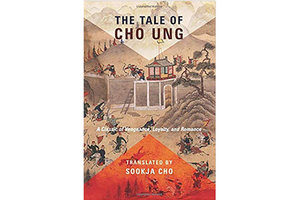'The Tale of Cho Ung' introduces Korean classic tale to English speakers
Sookja Cho offers the first-ever English translation of the pre-modern classic.

The Tale of Cho Ung
By Sookja Cho
Columbia University Press
240 pp.
Despite being “the best-selling fictional narrative during the late Chosŏn period” (1392-1910) of pre-modern Korea, little is known about the provenance of The Tale of Cho Ung. The author remains unknown and its initial composition has been narrowed down to a 200-plus-year-window, with a guesstimate falling somewhere between the late-18th to early 19th centuries. Its efficacy as immersive fiction, however, has historical documentation: originally popularized by professional storytellers reciting in public spaces, the heroic escapades of the eponymous Cho Ung – filial son, loyal advisor, honorable leader, unparalleled warrior – could be so intense as to incite an enthralled listener to attack the storyteller amidst an especially fierce scene.
Today, some 450 copies in multiple editions – manuscripts, woodblock prints, moveable-type commercial publication – survive. Gathering, analyzing, comparing, compiling, cross-referencing the many different editions, Sookja Cho, assistant professor of Korean and comparative literature at Arizona State University, worked through varying lengths and plot deviations to discover that “the overall narrative remain[ed] the same.” From that exhaustive compilation, Cho offers the first-ever English translation of the pre-modern classic with dual intentions: to “add to the understanding of this popular Korean tale among English-speaking readers and inspire scholars to build upon my work.” And yes, she assuredly succeeds in achieving both objectives.
For the curious Anglophone reader of world literature, “Cho Ung” is a dramatic adventure filled with royal intrigue, swashbuckling wars, filial duties, multigenerational revenge – and, of course, a swooning love story. Set in the mid-fifth century during China’s Liu Song Dynasty (420-479 CE) – “the use of a Chinese historical time and space was not unusual in late Chosŏn literature,” Cho explains – the tale opens during a “time of peace” in Emperor Mun’s court. The widespread tranquility is the direct result of the late Minister Cho Chŏngin who “saved the royal court from collapse,” earning him the distinction of being the Emperor’s “most loyal subject.” Slandered by jealous rival Minister Yi Tubyŏng, Minister Cho chooses honorable suicide rather than be part of Yi’s evil schemes; he dies before meeting his son, Cho Ung, who was then seven months in utero. The child’s given name, “Ung,” meaning “hero,” proves prophetic.
By age 7, Ung’s “extraordinary” nature is already so renowned as to have him summoned to Emperor Mun’s court “to discuss state affairs.” Precocious Ung politely declines the Emperor’s overgenerous appointment, but returns home to his widowed mother with the promise of a government post at 13. His court appearance, of course, doesn’t go unnoticed by envious Minister Yi who, despite his own powerful status and that of his five sons, is determined to kill Ung before the boy can avenge his father’s wrongful death.
By the next year, the Emperor, too, is dead, and Minister Yi usurps the throne from the 8-year-old crown prince. His public threats against Ung intensify, sending the hero and his mother on a difficult escape journey – which only fuels Ung’s maturing ambitions to restore justice. In between training and travels, battles and body counts, Ung falls for the faithful maiden, ensures his mother’s well-being, defeats his enemies, rescues the crown prince, rebuilds the empire, and gets his just rewards.
To ensure a smooth, narrative experience, Cho makes reading the 138-page adventure straight through easily doable, clearly separating the story from additional information, keeping even footnotes relegated off the page until after the final line. Readers might close the book fully satisfied with a glimpse of vernacular fiction from another time, a faraway culture while digesting a bit of sociopolitical history. But beyond simply enjoying literature-in-translation, Cho’s contextual enhancements (totaling an additional almost-100 pages) are emphatically laudable as well as rewardingly readable. Her comprehensive introduction provides a treasure trove of exacting details about versions of the classic tale, a parsing of its factual and imagined elements, astute character studies, textual insights – undoubtedly illuminating for the casual reader, surely motivating for the academic scholar. So, too, are her edifying endnotes and references essential sources of relevant information.
“The long-standing success of the tale,” Cho asserts, “is rooted in its role as an act of tikkun olam (repair the world) that fulfills people’s needs both for a champion and for an escape from everyday life.” For many potential readers, her timing couldn’t be more resonantly apt. "'The Tale of Cho Ung' allows premodern and modern audiences alike to travel through a world of wonders and symbolically defeat that which has caused their disillusionment.” Don’t we all need a valiant hero’s victory now more than ever?
Terry Hong writes BookDragon, a book blog for the Smithsonian Asian Pacific American Center.

